

Damion Smy
Boxy new KGM Musso unveiled to take on HiLux and Ranger ahead of Australian launch
12 Hours Ago
Fiat has made the bold decision to turn its iconic 500 city car into an electric vehicle. Has the Italian automaker made the right choice?
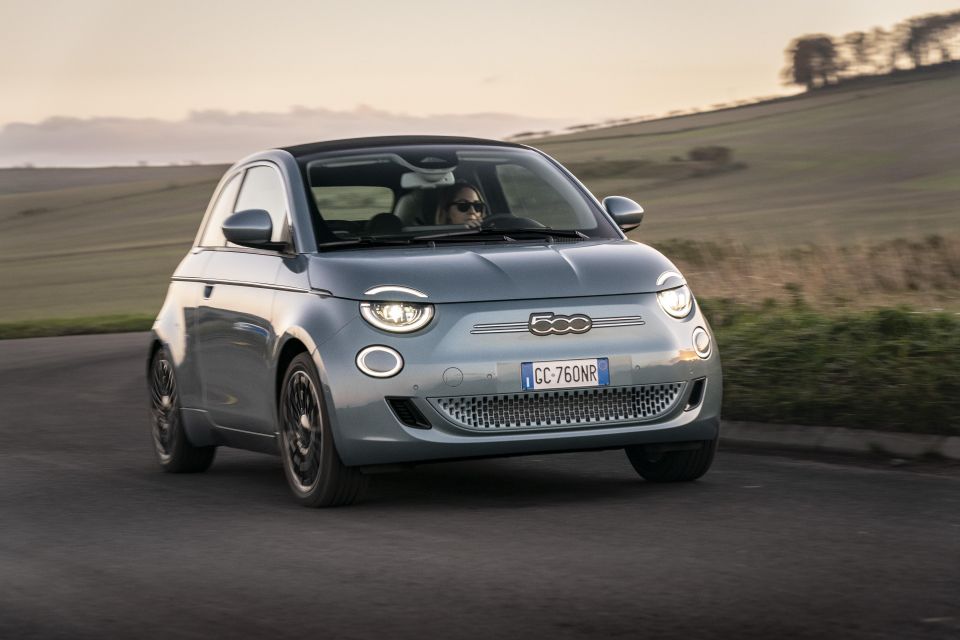


Contributor
New from
$19,250
excl. on-roads

Contributor
New from
$19,250
excl. on-roads


Contributor
New from
$19,250
excl. on-roads

Contributor
New from
$19,250
excl. on-roads
Quickly see how this car stacks up against its competition. Select any benchmark to see more details.
Where expert car reviews meet expert car buying – CarExpert gives you trusted advice, personalised service and real savings on your next new car.
There’s a significant overlap to the core premise of traditional city cars and forward-thinking electric vehicles (EVs), so – aside from potential packaging issues – it seems to make the most sense, in regard to current levels of battery technology, for manufacturers to turn their urban tearaways into EVs.
And that’s precisely what Fiat has done with its all-new 500, perhaps one of the most recognisable city cars in the world.
Built once more at the Mirafiori plant in Fiat’s home city of Turin in northern Italy, the New 500 – which we’ll from now on refer to as the 500e, not to be confused with the failed 2013 500e only marketed in the USA – will be sold alongside combustion versions of the existing model, which will become the ‘Classic 500’. Like what Fiat has done there?

However, the 500e is not simply the Classic 500 with an electric engine. It’s a new-from-the-ground-up machine on an EV-specific platform developed by FCA.
It will presage other all-electric Fiats on the same specialised chassis in the near future, so we could see a 500Xe in the coming months, for example. And we already know that this switch from ICE to electric will spell a seismic shift in the Abarth offering of hot 500s.
Until the inevitable arrival of all the crossover, MPV and high-performance derivatives though, the 500e will fly the electric flag for Fiat as both a three-door hatch and a two-door Convertible – the latter is what we’ve tested here.
It comes with two battery and electric motor options, and it must take on the likes of the Honda e and the Mini Electric for the affections of EV adopters who want a super-stylish, zero-emissions runaround as their daily conveyance. So, is this a brave new dawn for the 500e, or a large misstep on the part of its parent manufacturer?

As at the time of writing, the Fiat 500 EV hasn’t been confirmed for the Australian market.
The current Fiat 500 starts at $19,250 before on-road costs, but we don’t know how the electric model will compare.
In countries where its price has been confirmed, it doesn’t turn out to be ruinously expensive compared to the dowdy old ICE models it is superseding, but we cannot confirm as yet whether that trend will be repeated if the car is pencilled in for sale here.
For reference, the base hatchback starts at £19,995 ($35,092) in the United Kingdom which is around £6000 ($10,530) dearer than the base Classic 500 which now comes with mild-hybrid tech as standard in that region.
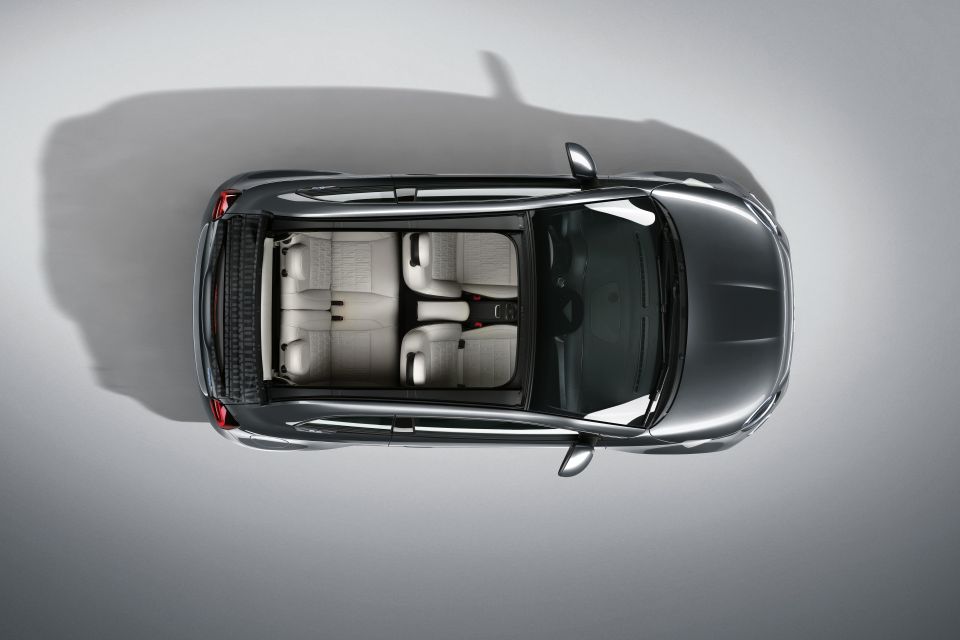
Buy your new car without the stress. It's fast, simple and completely free.

Great service from Travis and team, second time I have used this business would not hesitate to recommend them to anyone
Craig C.
Purchased a Ford Ranger in Sunshine Coast, QLD
CarExpert helped Craig save thousands on his Ford Ranger, now let us save you on your next new car.
Find a dealAgain, specs are not fully ratified but if we go by what Fiat in Italy is claiming of the vehicle for global markets, we’d expect all cars that may eventually arrive here to have at least 15-inch alloy wheels, LED daytime running lights and tail lights, a 7.0-inch TFT instrument cluster, manual air-conditioning, keyless go, rear parking sensors and automatic headlights.
Base-spec versions do not have an infotainment touchscreen, instead providing a cradle for owners to hook up their smartphone. Bear in mind Uconnect with Apple CarPlay and Android Auto is not available on these versions; you simply use your phone’s screen itself as your media display.
Higher-spec models gain a 7.0-inch touchscreen with smartphone mirroring, culminating in the Uconnect 5 OS on a 10.25-inch display on the top grades.
Other luxuries available on the 500e include radar cruise control, automatic climate control, 360-degree parking cameras, LED headlights, bigger 16- and 17-inch wheels, and rain-sensing wipers.
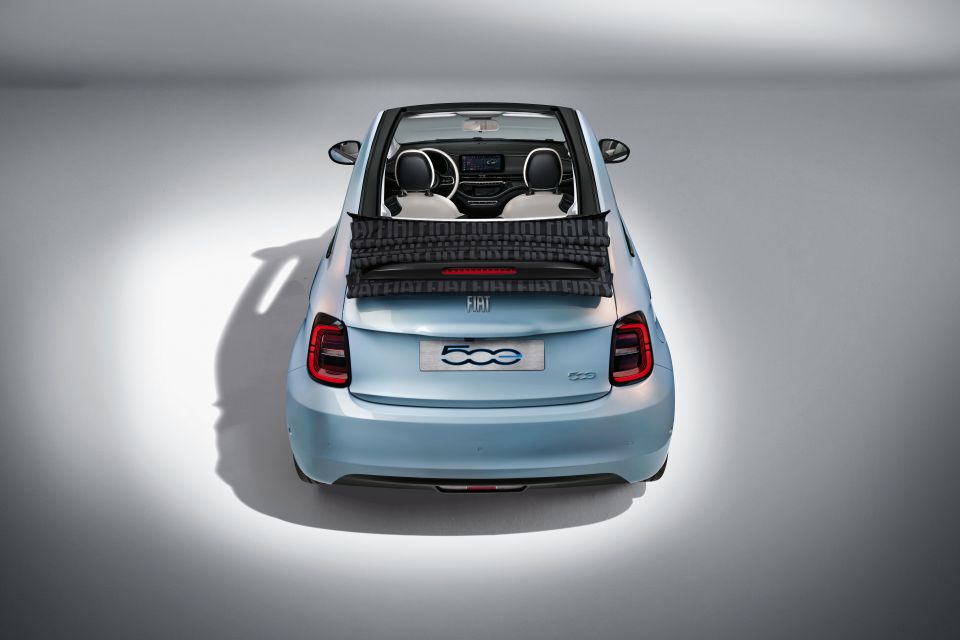
While the outgoing Fiat 500 picked up a five-star ANCAP rating when it was tested in 2008, crash safety requirements have become much more stringent since then.
We can’t even refer to Europe on this new one because, as yet, the Fiat 500e hasn’t yet been put through its Euro NCAP evaluation either.
Luckily, the 500e comes with lane keep assist, intelligent speed assist with traffic sign recognition, autonomous emergency braking with pedestrian and cyclist detection, and a tyre pressure monitoring system all as standard, which allows Fiat to claim that all models are Level 2 autonomous.
Options include blind-spot monitoring and adaptive cruise control with a Traffic Jam Assist function.

This is one of the Fiat 500e’s biggest strengths, because the cabin is an excellent affair blending the aesthetic goodness of a 500 dashboard with the requisite high-tech features of the 2020s and some little homages to where the car has come from.
Quite literally – if you look in the door pulls, for instance, you’ll see an outline drawing of the profile of the Nuova 500 from 1957, as well as that very year stamped into the rubber matting.
Or, on the versions with the centre-of-the-dash wireless smartphone charging slot, you’ll spot the skyline of Turin rendered in the base-pad, to celebrate the 500’s return to Mirafiori after many years of being built in Poland.
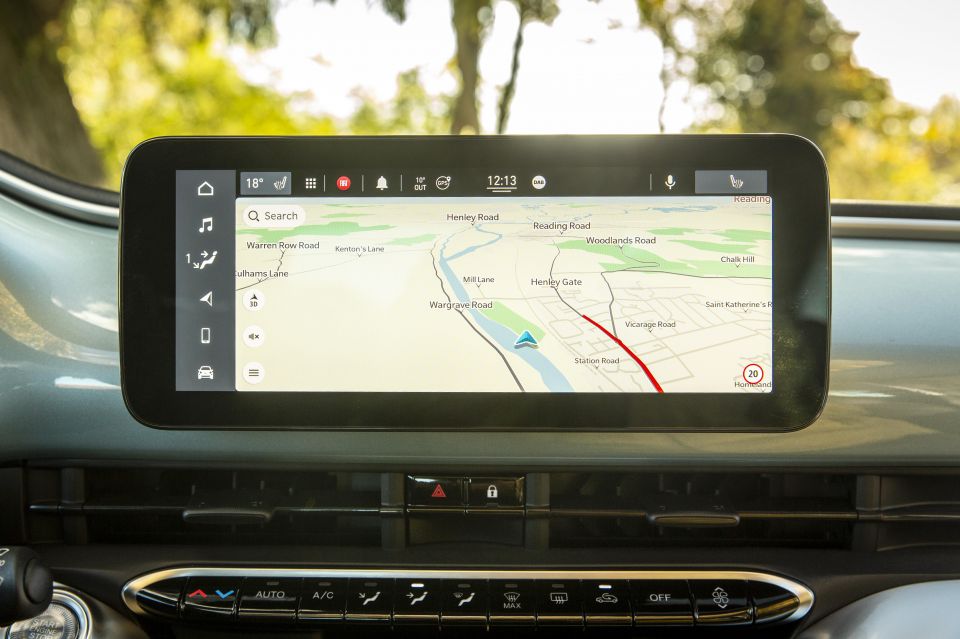
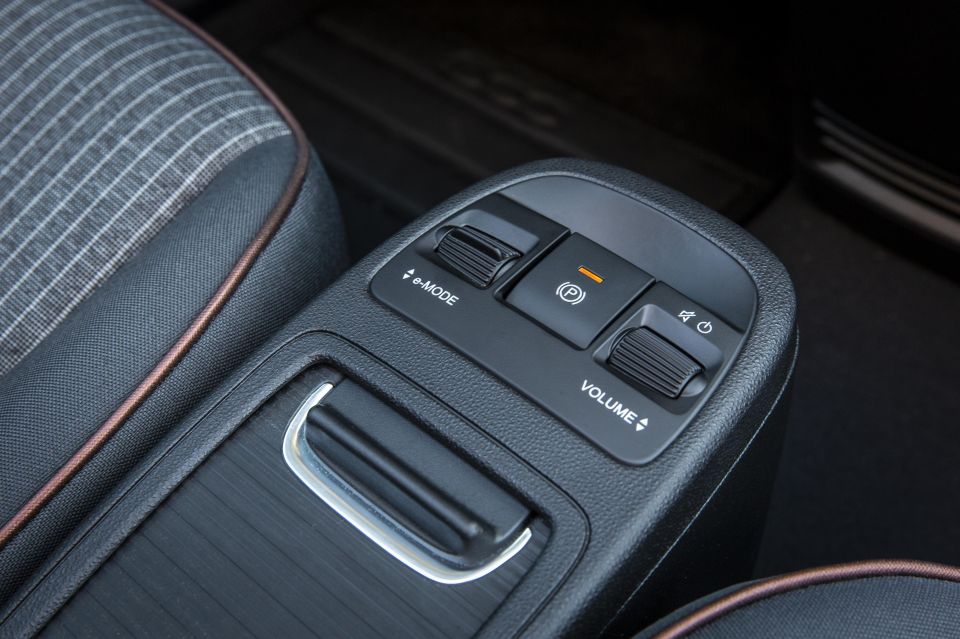
We’ll come back onto the good bits in a moment, but first we ought to point out that despite the car growing in all dimensions, Fiat attempting to call the 500e Convertible the ‘world’s first four-seater EV soft-top’ is pushing the boundaries of credibility somewhat.
Thanks to the 500e being 61mm longer (with 22mm of that stretch accommodated in the wheelbase, by the way), 56mm wider and 29mm taller, and also sitting on tracks which are 56mm broader, it is slightly more capacious within than the Classic 500 but we reckon you’ll still only fit four adults in the cabin of the Fiat if A) the front seats are adjusted to be just so in terms of position, and B) if all said adults are comfortably less than 1.75 metres tall.
Also, just getting into the back row isn’t the easiest manoeuvre going, as there’s not much space between the B-pillar and the tilted backrest of the front seat, but there’s talk of a 500e 3+1 model in the pipeline which would add a small, rear ‘suicide’ door on the passenger side.
Of course, that’s ‘passenger side’ for left-hand-drive markets, and Fiat has already confirmed it won’t ‘hand’ this door for worldwide territories, meaning if the 3+1 does come to our right-hand-drive roads then the rear door will see occupants disgorging directly into traffic flow. Hmm.
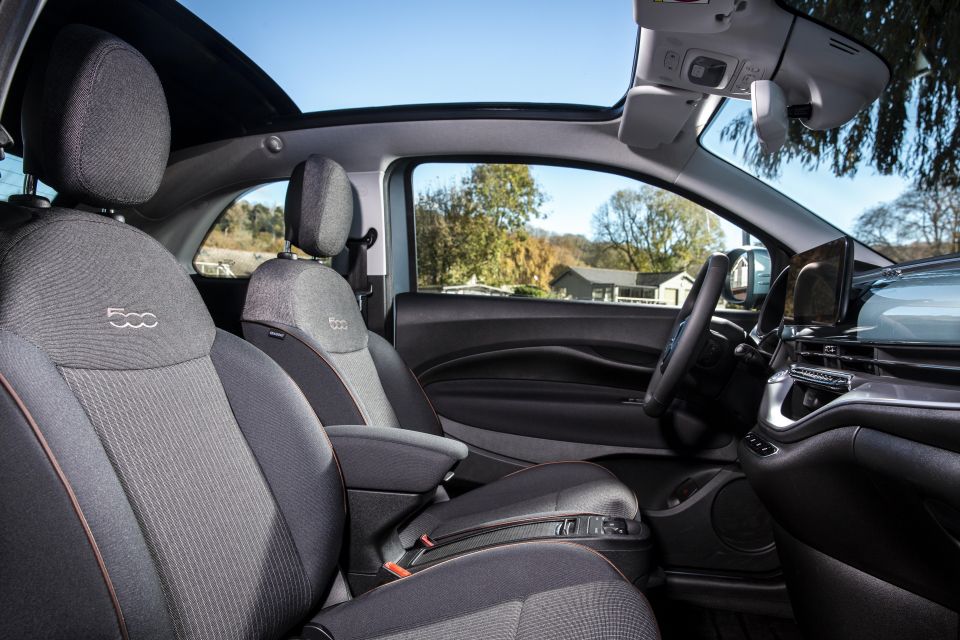
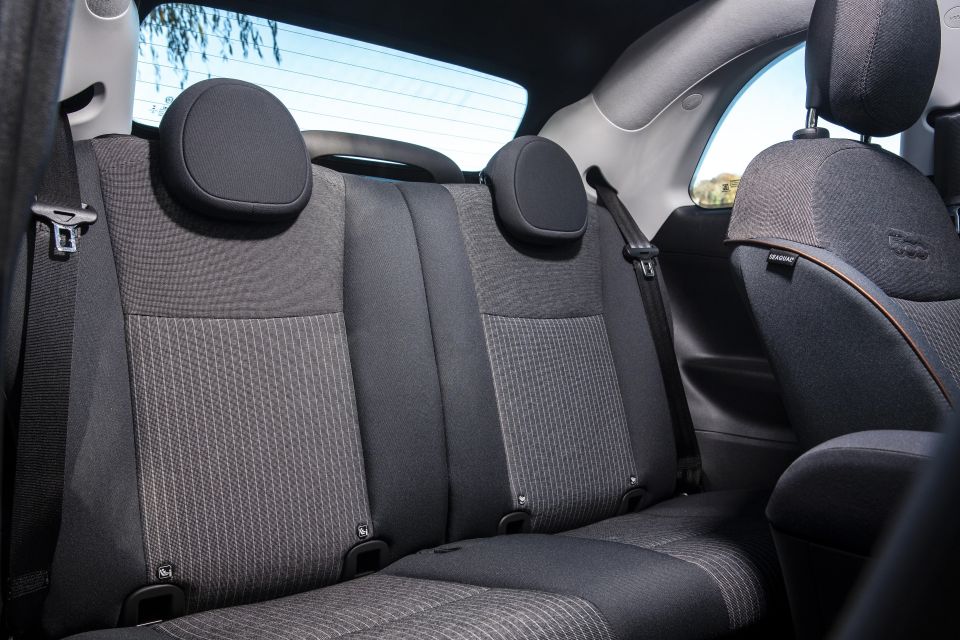
Anyway, beyond the cosy rear seats, the 500 Convertible packs a meagre 185-litre boot, although at least this hasn’t lost any capacity from the old ICE model because of its EV underpinnings.
It’s all superb up front, though. The car’s increased dimensions do give the impression of more space between front-seat occupants and the dashboard is a wonder to behold.
It has all the old 500’s visual verve, only with a proper, cutting-edge infotainment system presented on a 10.25-inch screen. The switchgear all looks good and feels classy to operate, and the lovely two-spoke wheel is a design flourish that we are delighted to see making a comeback in the 2020s.
The TFT cluster is also a top-notch execution of the technology type too, with clear, concise information displayed in pin-sharp detail. Overall, the 500e feels several large steps on from the Classic 500 in terms of the ambience of its interior.
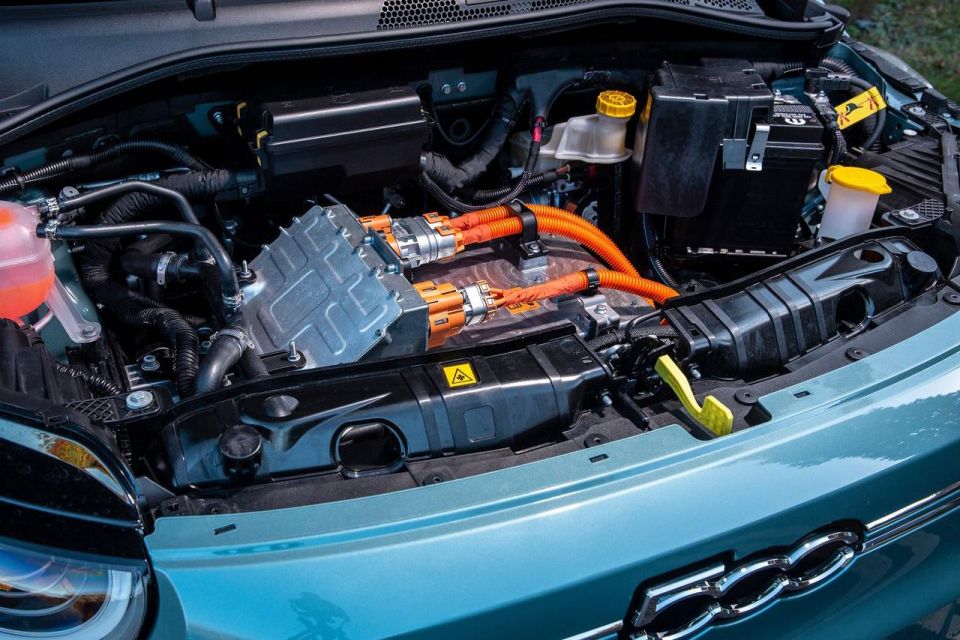
Two choices here, as you can have either the City spec 500 or the Long Range 500. The former uses a 23.8kWh lithium-ion battery pack with a 70kW electric motor, driving the front wheels through an offset-gear single-speed transmission.
It’s supposedly good for 185km of combined WLTP range on a single charge, as well as 0-100km/h in 9.5 seconds and a top speed of 135km/h.
The indications are, though, that the City drivetrain will be reserved purely for the most basic specification models of the hatchback only. In essence, almost all 500e variants will have this Long Range set-up, which sees a bigger 42kWh battery pack equipped to power an 87kW electric motor.
This delivers the same 220Nm as the City, but its additional grunt is enough to overcome the 100kg-plus weight gain of the bigger battery (the 23.8kWh unit is 182kg, while the 42kWh Samsung SDI is 290kg) to let the Long Range post a 9.0-second 0-100km/h time, as well as allowing the car to run on to a higher 150km/h top speed.
And this is the one we think we sell far better here, if both choices are offered, not because of the performance gains it provides but because the Long Range is said to be capable of up to 320km on a single charge of its battery on the WLTP combined cycle – and 400km of cautious city driving, purportedly.

It takes the merest handful of metres in the Fiat 500e before there’s a great big grin on your face. Because the Italian company has got one crucial aspect of this new EV absolutely spot on, and that’s its low-speed ride quality.
Given our test car was on some of the larger 16-inch alloys that can be fitted to the 500e, the way it could soak up both ripples in the road’s surface as comfortably as it could smother out large compressions and potholes encountered by the wheels was nothing short of remarkable.
This is a short-wheelbase, relatively lightweight car (1330kg as tested, which is trim for an EV) built to a budget – things like this are not supposed to ride as smoothly and as pleasantly as the 500e does.
And, principally, that’s the job done for the 500e. Seriously, what you want from an EV city car is for it to be comfortable in and around a conurbation’s pockmarked streets.
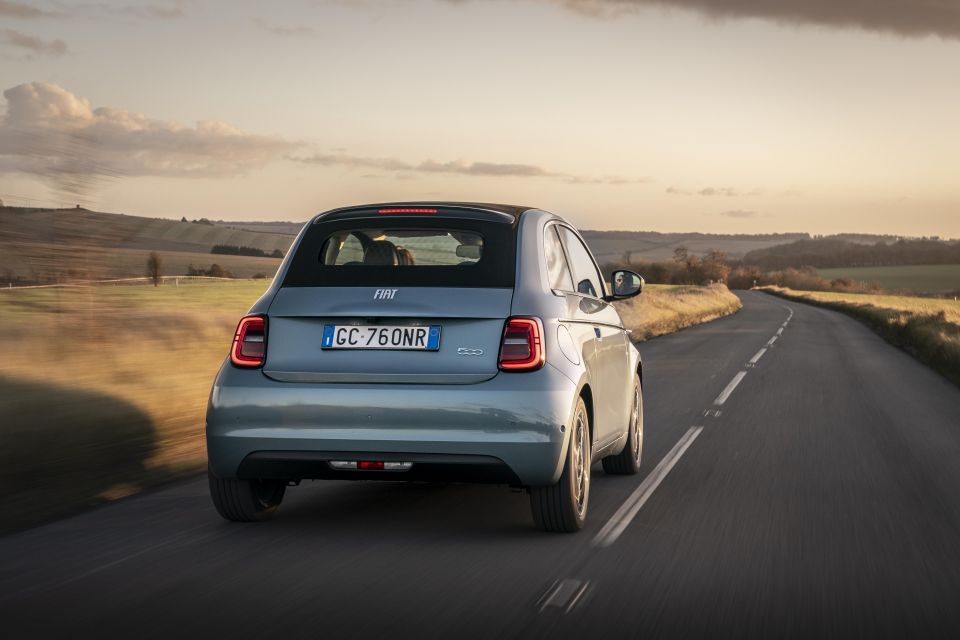
Many other rivals fail to accomplish this, trying to imbue their electric machines with some sort of needless gloss of handling panache when you get them out on more remote roads, but as this type of compact EV is hardly ever going to be traversing a mountain pass or doing a track day, this is a counterproductive operation. Refreshingly, it’s not a trap into which Fiat has blindly wandered with its new product.
What the Fiat 500e does so brilliantly from there is build on this epic ride comfort with excellent refinement to match.
With no ICE introducing vibrations into the shell nor additional noise to the passenger compartment, the Italian company has worked hard to ensure that passengers within are thoroughly acoustically isolated from any thumps the suspension might make while it’s working its magic, nor are the twin disturbances of wind and tyre noise permitted to contribute any significant disruption to occupant comfort.
To travel in the Fiat 500e Convertible up to any sub-three-figure speeds is a genuine pleasure, even with that fabric roof up top – oh, and you can retract it fully back electrically in 25 seconds, even on the move at up to 100km/h.
It’s a mighty well-judged drivetrain, too. There’s enough rapid acceleration from 0-50km/h to make the 500e great fun in towns, as it bursts away from junctions and traffic lights with mega traction and real vivacity, but the power delivery is never abrupt; the Fiat just smoothly and insistently picks up pace.
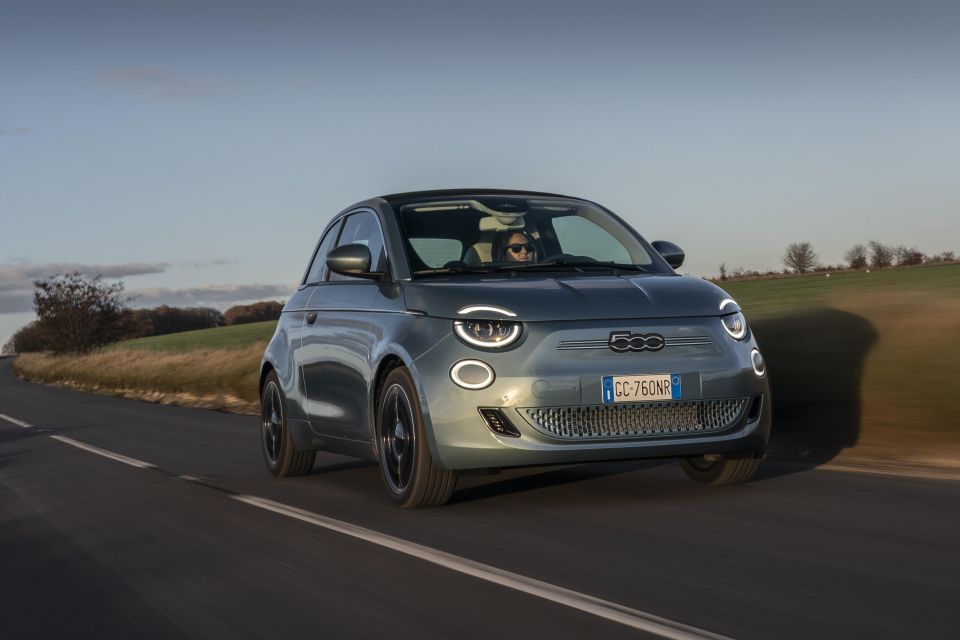
It feels pretty strong up to 100km/h too, so it isn’t hopelessly lost on out-of-town routes, and while its steering is necessarily lightweight in operation and lacking any meaningful feel, it is nevertheless very consistent across the lock and quick in action.
And then there’s the braking. So often something manufacturers misjudge on EVs and hybrids, where the brakes have to both harvest kinetic energy and slow down the vehicle, Fiat seems to have got the 500e’s retardation bang-on.
With three drive modes to go at, of Normal, Range and Sherpa, the first of these has hardly any regenerative braking effect at all. Lift off the ‘throttle’ and the 500e will coast like an ICE car, only decelerating because of the twin drag factors of rolling resistance from the tyres and the Fiat’s form pushing through the air.
To actually stop it, you need to press the brakes, whereupon you’ll revel in pedal progression that feels natural and positive underfoot, without any of the initial dead travel that is so common in electrified vehicles.
Step the Fiat up into Range and the throttle’s responsiveness is smoothed off, although the car will still accelerate as fast as it possibly can and will also go to its top speed, but the regen is now potent enough that the 500e can be driven on one pedal alone.
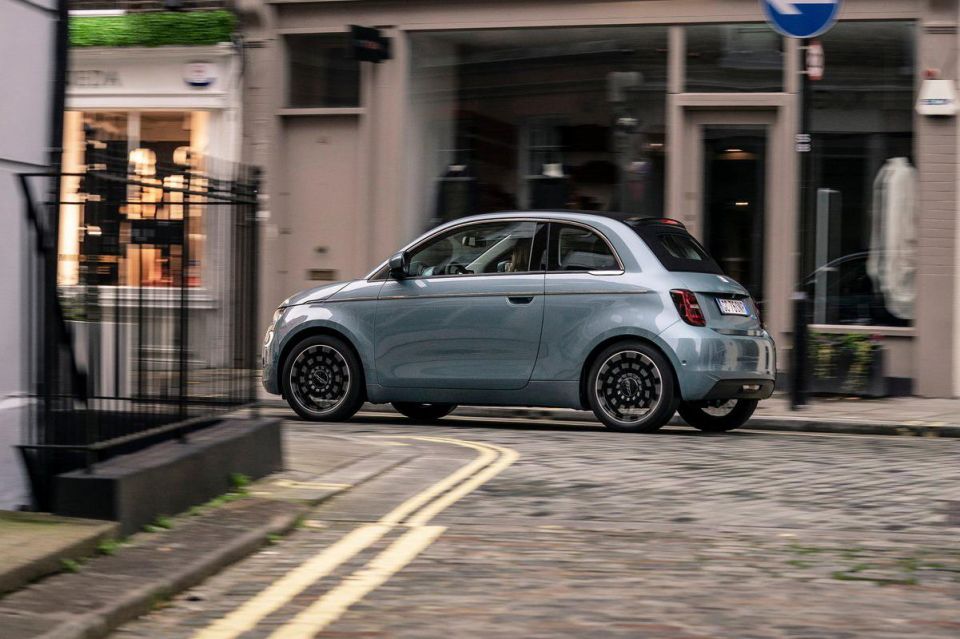
This, like the actual brake travel, is again spectacularly well-calibrated, making driving the Fiat with the just the right-hand pedal an absolute breeze in urban areas. You’ll rarely miscalculate where and when you need to ‘lift’ to get the car to stop for an impending obstruction or traffic sign.
Finally, Sherpa is a ‘get me home’ last resort setting, which doesn’t alter the level of the regenerative braking but it does limit the 500e to 80km/h maximum, while simultaneously switching off all non-essential electrical drains on the system – so things like the heated seats, climate control and stereo system, but not items such as the headlights or the wipers.
You may switch these deactivated bits of equipment back on in Range, if you so wish, but the idea is that you eke as much distance as possible out of the remaining battery charge, and lightly toasting your backside with the seat is not going to help with this endeavour.
If there’s any criticism of the way the 500e goes about its business, it’s when you ask a lot of the chassis it has few answers to a serious dynamic examination.
Understeer is limited to a bare minimum, but once grip goes, so does the Fiat’s composure until the tyres can find purchase once more. It’s therefore not a car to reward the keener driver. Most owners will never approach such limits, so its handling shortcomings are not something with which you can beat the 500 EV with a critical stick.
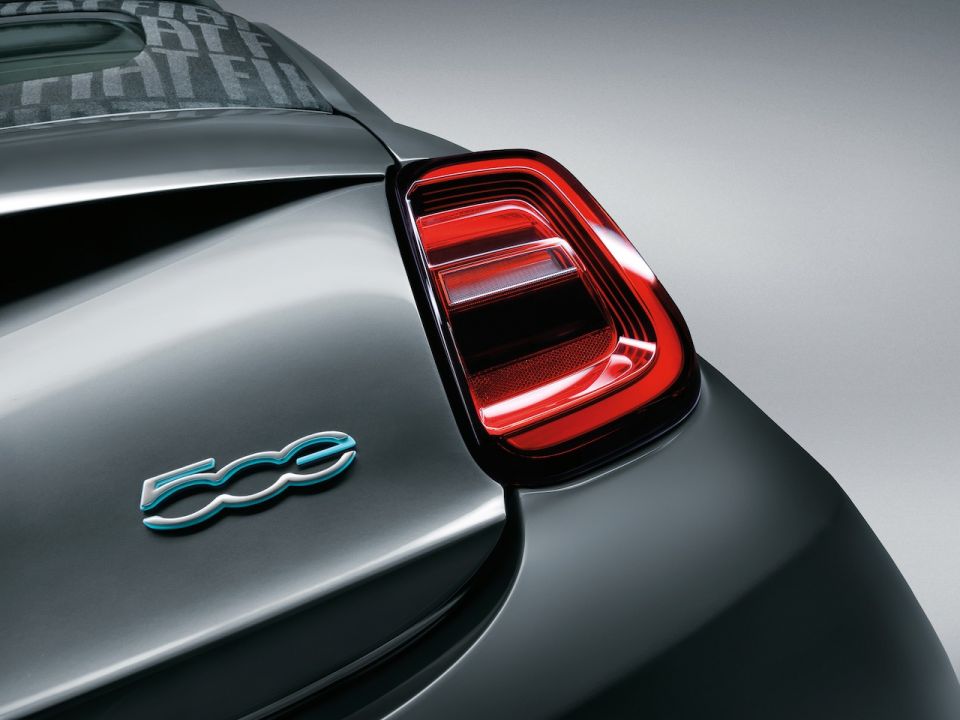
Where expert car reviews meet expert car buying – CarExpert gives you trusted advice, personalised service and real savings on your next new car.
We’ll refrain from talking specifics about running costs until we know more about Australian pricing, but of course the small, light Fiat 500e shouldn’t break the bank to run.
Fiat claims energy usage of 13.1kWh/100km, which is one of the lower consumption figures in the world of all EVs, while there are decent charging options available, too.
All 500e models come with an onboard 11kW AC-DC charger, a CCS Combo 2 charging port and a Type 2 charging cable as standard. A Type 3 cable will be a cost option.
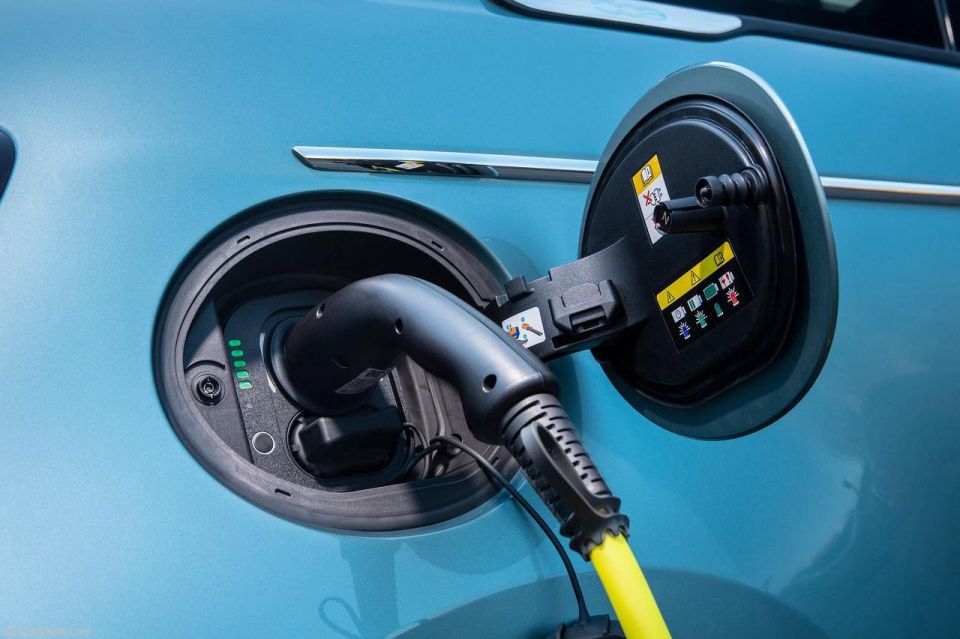
The City version’s smaller battery seems to win the charging speeds battle compared to the Long Range: on AC 3kW domestic connections, it will take 8 hours 45 minutes to totally charge a fully depleted 23.8kWh battery, whereas the 42kWh item requires nearly double that time at a lengthy 15 hours 15 minutes.
It’s the same story on an 11kW AC charging station, the City going from 0-100 per cent battery in 2.5 hours, compared to the Long Range’s 4 hours 15 minutes.
But it’s far closer on DC fast charging times, mainly because the Long Range can replenish its battery at a maximum rate of 85kW compared to the City’s 50kW peak.
Nevertheless, the City is still, marginally, less time-consuming again – it’ll go from 0-80 per cent of the battery’s state in half-an-hour, while the Long Range requires 35 minutes to acquire the same charge.

Combining the best aspects of an EV with the traditional, desirable strengths of the Fiat 500, this electric ‘Nuova 500’ is a revelation.
It’s a zero-emissions city car executed fantastically well, majoring on ride comfort, rolling refinement and clever management of its battery before trying to deliver a sporty drive or ludicrous step-off performance. Therefore, it’s a real-world gem, something that makes any impending enforced-by-legislation move to EVs that much more palatable to consider.
Once we know prices and specs for the Fiat 500e, we can give it a fuller appraisal and mark it accordingly, but what we are already well aware of is we want this exceptional little city electric car to make its way to our market – preferably much sooner than later.
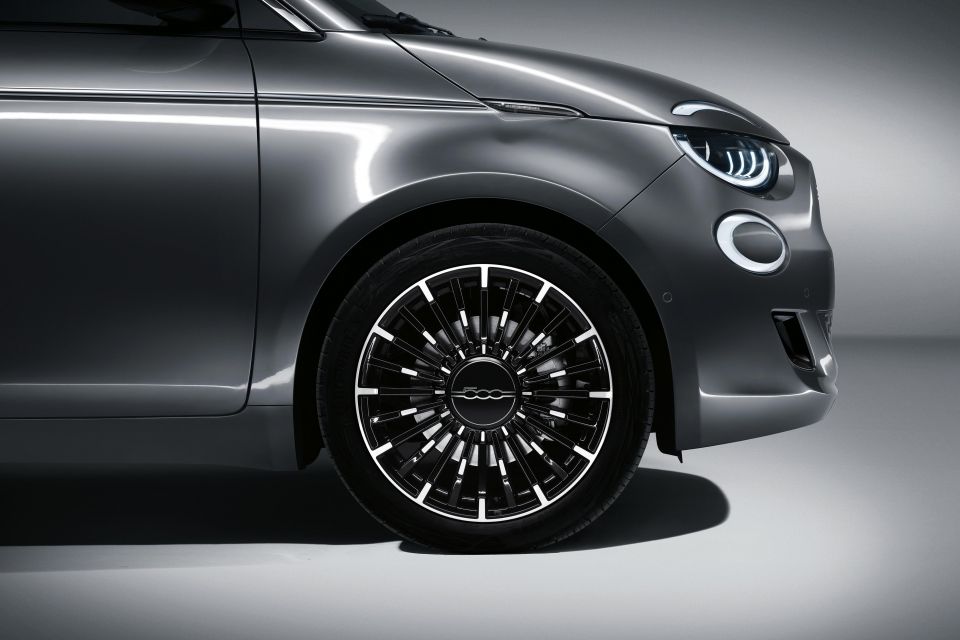
Click the images for the full gallery
MORE: Fiat 500 news and reviews MORE: Everything Fiat
Where expert car reviews meet expert car buying – CarExpert gives you trusted advice, personalised service and real savings on your next new car.


Damion Smy
12 Hours Ago


Damion Smy
14 Hours Ago


Damion Smy
15 Hours Ago


Damion Smy
17 Hours Ago


Damion Smy
18 Hours Ago


Damion Smy
20 Hours Ago